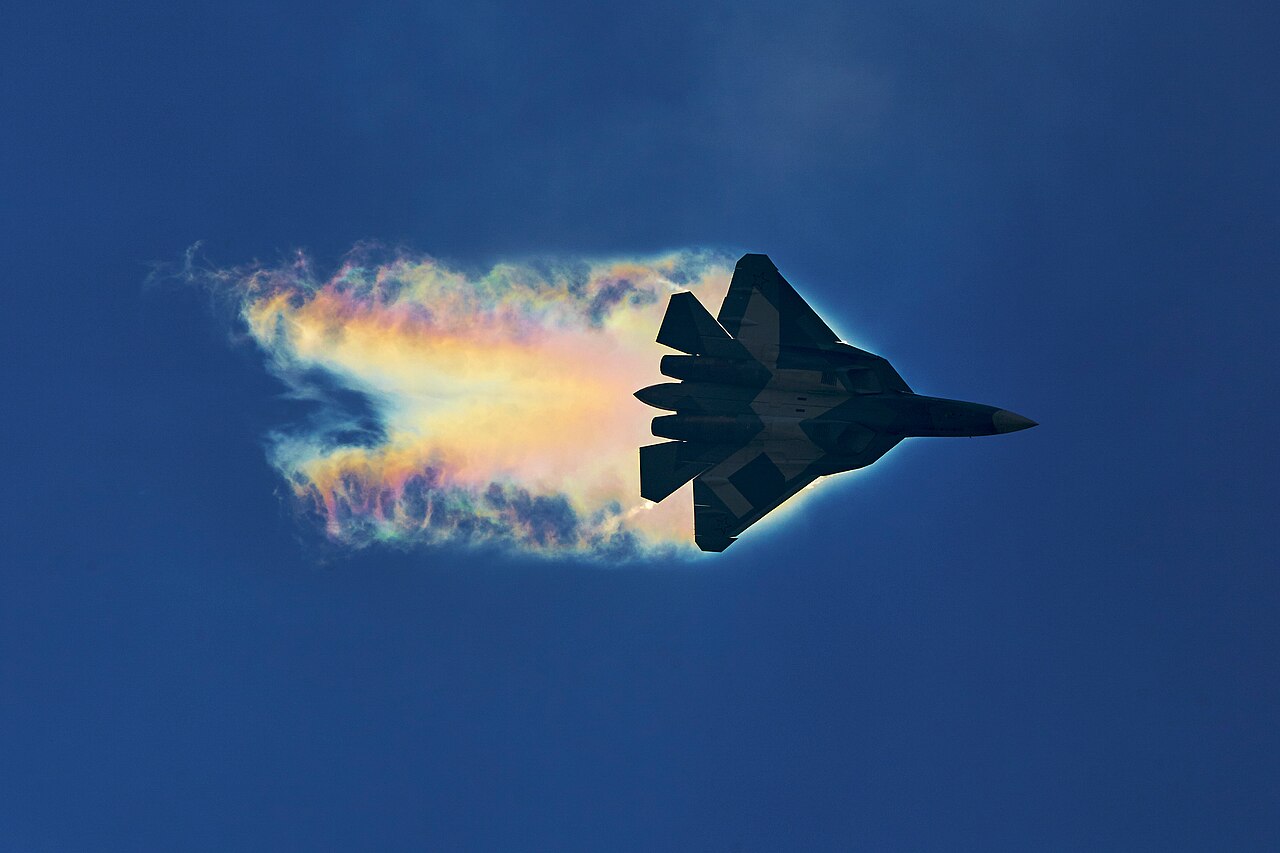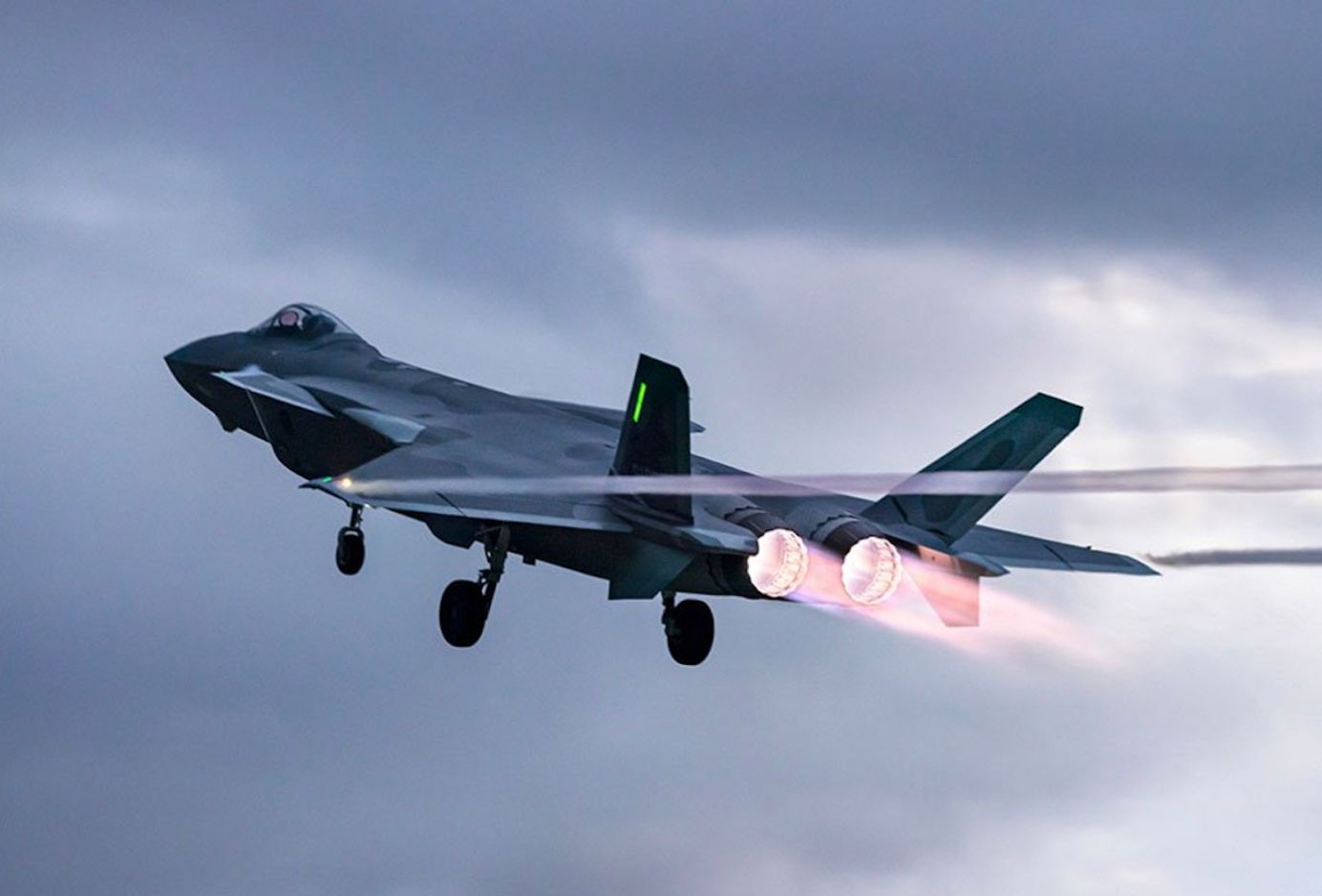Air forces of 19 countries of the world are already operating fifth-generation fighter aircraft. While China operates its own Chengdu J-20 ‘Mighty Dragon’, and Russia its Sukhoi Su-57 ‘Felon’, 17 countries are operating the Lockheed Martin F-35 Lightning II. The only other fifth-generation fighter, the Lockheed Martin F-22 Raptor, is operated by USA alone. Only three countries have been original designers of fifth-generation aircraft: the USA, China, and Russia. Though many countries are design and production partners of F-35.
Indian Air Force (IAF) is considered the fourth largest and most powerful air force in the world. The IAF does not have a fifth-generation fighter, despite joining the Sukhoi/HAL Fifth Generation Fighter Aircraft (FGFA) project based on the Russian Sukhoi Su-57.
The completed FGFA was to include 43 improvements suggested by India over the Su-57, including advanced sensors, networking, and combat avionics. The Indian version was to be a two-seater with a pilot and a weapon systems operator (WSO). India withdrew from the FGFA program in 2018, but a small window for a revisit was left open.
Small numbers of the Russian Su-57 Felons have entered squadron service and have seen limited action in Syria and Ukraine. Chinese J-20 numbers are growing rapidly, and nearly 250 have already been built. J-20 has been seen at airfields across the LAC (Line of Actual Control) in Xinjiang (Hotan) and Tibet (Shigatse).
While India has decided to pursue its fifth-generation fighter, the Advanced Medium Combat Aircraft (AMCA), Su-57 remains on offer. F-35 is currently not cleared for India since it purchased the Russian S-400 AD system. In the hypothetical condition that India was to acquire a few Su-57s as a stop-gap arrangement, Felon’s comparison with the Mighty Dragon becomes relevant.
Sukhoi Su-57 ‘Felon’
The Sukhoi Su-57 is a twin-engine stealth multirole fighter aircraft, the initial development of which was initiated in 1999 as Sukhoi’s internal designation T-50. It was to be the first stealth aircraft to join the Russian military.
In 2009, the aircraft’s design was officially approved. The first flight took place on 29 January 2010. The T-50 was named Su-57 in July 2017. The formal Russian Aerospace Forces service induction was in 2020, with the numbers built to date: 32 (10 test and 22 serial aircraft).
The multi-role fighter aircraft is meant for air superiority missions and can take on surface and maritime targets. It incorporates stealth, super-maneuverability in all aircraft axes, super-cruise, integrated avionics, and large payload capacity. The aircraft is meant to succeed the MiG-29 and Su-27 in the Russian military and is being marketed for export. The project has seen both technological and funding delays.
During initial testing, the prototypes were found to lack adequate fatigue life, with early structural cracks forming in the airframe. This required structural redesign.
Main Features Of Su-57
The aircraft has a wide blended wing body fuselage with two widely spaced engines and all-moving horizontal and vertical stabilizers. It makes extensive use of composites, which comprise 22–26% of the structural weight and approximately 70% of the outer surface.

Extensive work has been carried out to reduce radar cross-section (RCS) and IR signatures to make it stealthy. Even the aircraft canopy is coated with metal oxide layers for enhanced radar wave absorption. There is a greater emphasis on frontal stealth. The shaping of the aft fuselage is less optimized for radar stealth compared to its American counterparts.
The ’ Integrated Modular Avionics Combat Systems’ uses fiber optic channels. It consists of the main nose-mounted N036-1-01 X band active electronically scanned array (AESA) radar with 1,514 T/R modules and two side-looking N036B-1-01 X-band AESA radars with 404 T/R modules embedded in the cheeks of the forward fuselage for increased angular coverage.
The nose antenna is tilted backwards for stealth. It also has an N036L-1-01 L-band array on the leading edges. Onboard computers process the X- and L-band signals, significantly enhancing the system’s information.
The aircraft’s electro-optical system includes infrared search and track (IRST), directional infrared countermeasures (DIRCM), ultraviolet missile approach warning sensors (MAWS), a thermal imager for low-altitude flight and landing, and a navigation and targeting pod.
The aircraft is capable of deploying countermeasures such as flares and radar decoys, as well as single-use programmable ECM transmitters. The Su-57 would also serve as a test-bed for advanced AI and man-unmanned teaming technologies.
The Su-57 is powered by a pair of NPO Lyulka-Saturn AL-41F1, augmented turbofans with 88.3 kN dry thrust, 142.2 kN in afterburner, and 147.1 kN in emergency power rating. The aircraft employs thrust vector control (TVC) in rotational axes like in the Su-30MKI.
The Su-57 has two tandem main internal weapon bays, each approximately 4.4 m long and 0.9 m wide, and two side weapon bays with triangular section fairings under the fuselage near the wing root. Aircraft can carry four beyond-visual-range (BVR) missiles (R-37M) in its two main weapons bays and two short-range missiles (upgraded R-74) in the side bays. It can carry bombs and surface-attack missiles on each station in the main bay.

For missions that do not require stealth, the Su-57 can carry stores on its six external hardpoints, which could include the hypersonic Kh-47M2 Kinzhal air-launched ballistic missile.
Combined with a high fuel load, the fighter has a supersonic range of over 1,500 km, more than twice that of the Su-27. An extendable refuelling probe is available to further increase its range.
Slow Production & Induction
In 2011, Russia’s MoD planned to buy the first 10 aircraft for evaluation and 60 production standard aircraft from 2015 onwards. These plans were refined to acquire 52 aircraft by 2020 and another 150–160 by 2025.
These were further refined in June 2018 when an order for 12 aircraft was agreed upon. Deliveries to the Russian Armed Forces were pushed back to 2019 when the contract for the 76 aircraft was formally signed for deliveries by 2028. Serial production of the aircraft began in July 2019. Because of delays, additional Su-35 variants had to be inducted.
With the opening of a new production line in 2022, 12 Su-57s could be delivered to the Russian Air Force by the end of 2023. Another 20 aircraft are expected to be built in 2024, making the Su-57 the most-produced jet fighter in Russia.
Su-57 Deployments
In 2018, two Su-57s deployed at the Russian Khmeimim air base in Syria. The fighters were deployed along with four Sukhoi Su-35 fighters, four Sukhoi Su-25s, and one Beriev A-50 AEW&C aircraft. A Su-57 reportedly fired a cruise missile in combat, likely a Kh-59MK2. They reportedly flew around 10 sorties in Syria.
The first operational unit to be equipped with the Su-57 is the 23rd Guards Fighter Aviation Regiment, based in Dzyomgi in the Eastern Military District. Deliveries began in 2023, and all 24 aircraft will be delivered by 2025.
Russians have reportedly used Su-57 fighters to strike targets in Ukraine with stand-off missiles but remained outside of the zone of Ukrainian air defences. Su-57s were also used in the SEAD role.
They claimed that the low radar visibility was demonstrated in combat. They claimed kills in both air-to-air and air-to-ground roles, including shooting down a Ukrainian Su-27 with a long-range R-37 missile.
By May 2024, Ukrainian sources reported that Russians had intensified the use of Su-57 fighters to strike targets in Ukraine. On 9 June 2024, Ukraine’s Main Directorate of Intelligence released satellite images showing a purportedly damaged Su-57 at Akhtubinsk Airfield following a Ukrainian drone strike on the air base 600 kilometres from the border.
Future Developments Of Su-57
Ukraine War-related sanctions did initially slow down imports of semiconductors and high-tech machining equipment from the European Union. The United Aircraft Corporation (UAC) reported that an upgraded Su-57 aircraft made its first flight on October 21, 2022.
The upgraded Su-57M will be equipped with an underdeveloped new engine designated AL-51F-1, with 107.9 kN dry thrust and 167 kN in the afterburner. Glass-fibre plastic IGVs and a new nozzle with serrated flaps will further reduce the rear radar and IR signatures.
Work is on to integrate the Okhotnik UCAV as a ‘loyal wingman’ for uncrewed teaming. A carrier-based variant of the aircraft is also under development. Reportedly, a ‘swarm’ teaming experiment had been conducted with a group of Su-35s and a Su-57 acting as a command and control aircraft.
Fifth Generation Fighter Aircraft (FGFA)
On 18 October 2007, Russia and India signed a contract between Sukhoi and Hindustan Aeronautics Limited (HAL) to jointly develop a derivative of the evolving Su-57, called the Fifth Generation Fighter Aircraft (FGFA).
In September 2010, India and Russia agreed on a preliminary design contract in which each country would invest $6 billion; a memorandum of understanding for the preliminary design was signed in December 2010, and the development of the FGFA was expected to take 8–10 years.
By 2014, however, the IAF began voicing concerns over performance, cost, and work share. India found that the aircraft did not meet its requirements and eventually left the partnership in 2018. Russia still hopes to get India on board. The reported base price of the aircraft is unbelievably as little as $35 million.
The Chengdu J-20 ‘Mighty Dragon’
The Chengdu J-20 “Mighty Dragon” is a Chinese twinjet stealth fifth-generation fighter aircraft. It is designed as an air superiority fighter with precision strike capability. The aircraft has three variants: the initial production model J-20A, the thrust-vectoring J-20B, and twin-seat aircraft teaming capable J-20S.
The aircraft made its first flight in January 2011, and the first J-20 combat unit was formed in February 2018. Thus, China is the second country in the world and the first in Asia to field an operational stealth aircraft. Nearly 250 have been built as of date.
The J-20 has a long and blended fuselage with a chiselled nose section and a frameless canopy. There are low-observable diverterless supersonic inlet (DSI) intakes. It has all-moving canard surfaces with pronounced dihedral.
The canard design is known to provide good supersonic performance, excellent supersonic and transonic turn performance, and improved short-field landing performance. The aft section has twin outward canted all-moving fins, short but deep ventral strakes, and conventional or low-observable engine exhausts.
The aircraft reportedly has the Type 1475 (KLJ-5) active electronically scanned array (AESA) radar with 1856 transmit/receive modules. Some others feel that the radar is likely to contain 2000–2200 transmit/receive modules.
Six electro-optic sensors called the Distributed Aperture System can provide omnidirectional coverage for the pilot with a sensor fusion system combining the radar signal with the IR image to provide better situational awareness.
Analysts believe that the aircraft’s fins/strakes and axisymmetric rear areas may expose it to radar, but the J-20’s overall stealth shaping is robust and considerably more capable than the Russian PAK-FA.

For initial flight testing, the Russian AL-31FM2 engines were used. The aircraft is currently powered by a Chinese WS-10C engine with a thrust of 142-147 kN and serrated afterburner nozzles for enhanced rear-aspect stealth. The final intended powerplant is the Shenyang WS-15 with a thrust of 180 kN, which is crucial for supercruise and enhanced manoeuvrability.
The main weapon bay can house both long-range air-to-air missiles (AAM; PL-12, PL-15 – PL-21) and precision-guided munitions. The two smaller lateral weapon bays behind the air inlets are intended for short-range AAMs (PL-10). The Pentagon reported that China planned to upgrade the weapons bay to accommodate six missiles. The aircraft also has four external hard points for non-stealthy missions/ferry flights.
The estimated production rate was 40 to 50 airframes per year in 2022 and 100 to 120 airframes per year in 2023. The PLA Air Force (PLAAF) currently has around 240 aircraft. The aim is to match and counterbalance the increasing number of F-35 fighters deployed by the United States in the Western Pacific region. The J-20 fleet could reach 1,000 aircraft by the early 2030s.
Chinese media reported that the J-20S, a twin-seat variant, was under development for use in tactical bombing, electronic warfare, and carrier strike roles. Thus, the J-20S will be the first-ever two-seat stealth fighter.
The twin-seat allows the second operator to coordinate attacks and reconnaissance missions and manage unmanned combat aerial vehicles (UCAVs) linked via “loyal wingman” systems and sensors. China is known to be developing AVIC Dark Sword and stealth Hongdu GJ-11 UCAVs that can fly in the “loyal wingman” role.
Around ten brigades have completed the transition to the new fighter platform. J-20s have started regular patrols in the South China Sea. The J-20 has yet to leave Chinese soil, even for an air show. It has never been exercised with any foreign air force. J-20s have been seen at airbases across the India-China Line of Actual Control.
Su-57 & J-20 Comparison
| Su-57 | J-20 | |
| Country | Russia | China |
| Length | 20.1 m | 21.2 m |
| Wing Span | 14.1 m | 13.01 m |
| Empty weight | 18,000 kg | 17,000 kg |
| Max Take-Off Weight | 35,000 kg | 37,000 kg |
| Top Speed | Mach 2 | Mach 2.0 |
| Internal Bays and Payload | 4 – 4xR-37M, & 2x R-74 | 3 – 4xPL-15 & 2xPL-10 |
| Range Internal Fuel | 3,500 km | 2,500 km |
| Engine and Thrust | 2 × Saturn AL-41F1(147.1 kN) | 2 × Shenyang WS-10C (147 kN) |
| Radar and Range | Byelka radar. AESA, (400 km) | Type 1475 (KLJ-5) AESA, 300 Km |
| AAM (Range) | R-37 (missile), 200-400 km | PL-15, 200-300 Km |
Combat & Commercial Competition
The J-20 is one example of how China has transitioned from being dependent on Russian technology to developing indigenous sensors and weapons that are superior to those of Russia. While the Su-57 has seen limited combat in Syria and Ukraine, the J-20 has yet to leave Chinese shores.
India remains Russia’s most desired customer. However, India has not been responding to the overtures and is keen to develop its own AMCA. After the FGFA experience, India knows the Su-57’s limitations. Also, India cannot put more eggs in the Russian arms basket. But in case of inordinate delays in AMCA and Pakistan acquires a fifth-generation fighter, India may have no choice but to take a fresh look.
The Chinese and Russian aircraft will compete in the same markets in Africa, West Asia, and Southeast Asia. Both aircraft will be cost-competitive.
On 27 December 2019, Algeria signed a contract for 14 aircraft as part of a larger military deal that also includes the purchase of Su-34 and Su-35 fighters. Algeria is set to receive the first Su-57E in 2028.
It has been reported that Vietnam may become a customer of the Su-57. Russia has offered Su-57E fighters to the United Arab Emirates, and Iraq has also shown interest in the Su-57. As of date, no Su-57 fighters have been exported.
With China aggressively growing its fleet of J-20 stealth fighters and Pakistan indicating its interest in a Chinese stealth fighter (FC-31), India needs to act fast. Before AMCA arrives, India needs a stop-gap solution. The US F-35 could be a great option, but it is not officially on the table as of now.
The other option for the IAF is to explore the Su-57 and even the Su-75 Checkmate that Russia is proposing. Remember, India has kept all its options open!



